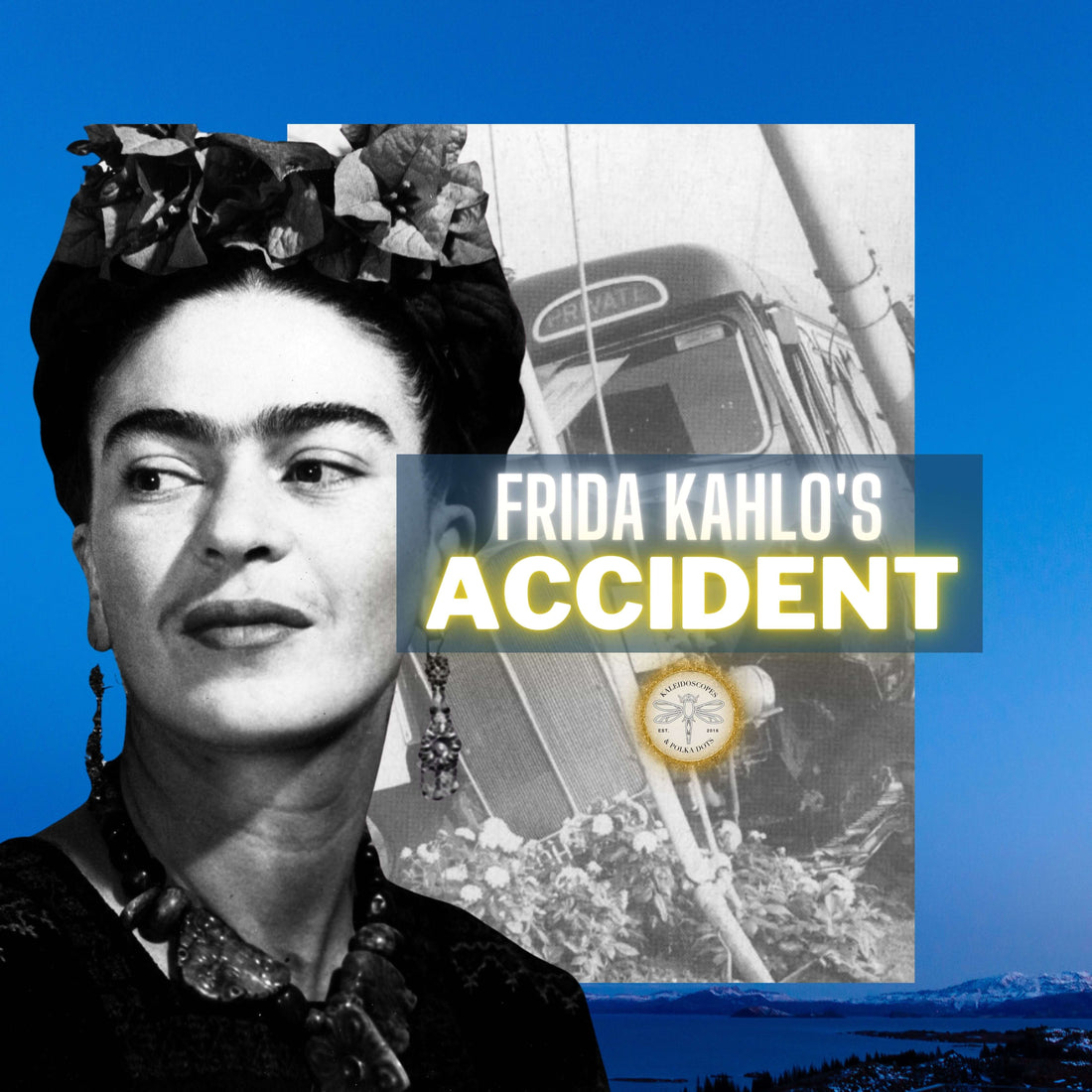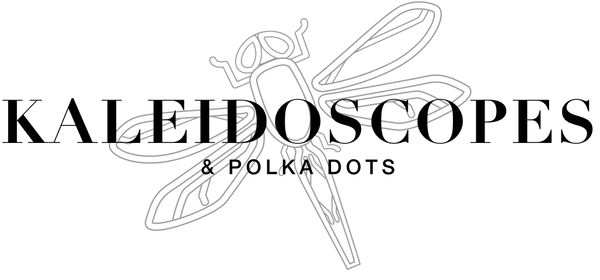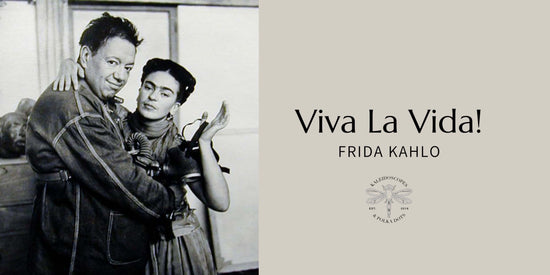
Frida Kahlo's Accident - September 17th, 1925
Share
"It was a strange collision...It was not violent but rather silent, slow, and it harmed everybody. And me most of all."
Frida Kahlo - Recounting Her Accident (Hayden Herrera's Book Frida: A Biography Of Frida Kahlo)

Table of content
VIDEO: Frida Kahlo's Accident
VIDEO CHAPTERS: Frida's Accident
00:00 OPENING
00:11 FRIDA KAHLO'S ACCIDENT INTRO
01:41 SOURCE: HAYDEN HERRERA'S BOOK FRIDA: A BIOGRAPHY OF FRIDA KAHLO
01:51 KALEIDOSCOPES AND POLKA DOTS
04:16 SETTING THE STAGE: WHAT WAS HAPPENING IN 1925
12:26 FRIDA KAHLO'S ACCIDENT - IN HER WORDS
14:28 ALEJANDRO GOMEZ ARIAS RECOUNTS THE ACCIDENT
17:02 "LA BAILERIAN" STILL OF THE ACCIDENT FROM THE MOVIE, FRIDA
17:44 FRIDA KAHLO'S INJURIES FROM THE BUS ACCIDENT
18:37 OUTRO
19:33 REGISTER TO VOTE! YOUR VOICE MATTERS!
Frida Kahlo's Accident As Recounted In Hayden Herrera's Book - Frida: A Biography Of Frida Kahlo
Hayden Herrera's in-depth book - Frida: A Biography Of Frida Kahlo - describes the accident as follows:
Far from being a unique piece of bad luck, such accidents were common enough in those days in Mexico City to be depicted in numerous retablos. Buses were relatively new to the city, and because of their novelty, they were jammed with people while trolley cars went empty. Then, as now, they were driven with toreador bravado, as if the image of the Virgin of Guadalupe dangling near the front window made the driver invincible. The bus in which Frida Was riding was new, and its fresh coat of paint made it look especially jaunty.
The accident occurred late in the afternoon on September 17, 1925, the day after Mexico had celebrated the anniversary of its independence from Spain. A light rain had just stopped; the grand gray government buildings that border the Zocalo looked even grayer and more severe than usual. The bus to Coyocan was nearly full, but Alejandro and Frida found seats together.
“It was a strange collision...It was not violent but rather silent, slow, and it harmed everybody. And me most of all.”
Frida Kahlo
The girl whose wild dash through school corridors resembled a bird’s flight, who jumped on and off streetcars and buses, preferably when they were moving, was now immobilized and enclosed in a series of plaster casts and other contraptions.


Life in 1925 - The Year Of Frida Kahlo's Accident

"Fashion is not an island. It's a response."
Amanda Hallay, The Ultimate Fashion History
Such a wise quote can easily be applied to more than just fashion.
It applies to everyday life.
As it applies to Frida's accident, the novelty and popularity of taking the bus versus a trolly certainly affected the day's events.
Plutarco Elias Calles, President of Mexico from 1924 to 1928, prioritized:
- infrastructure
- building a road network that linked major cities and small villages
- industry
- a strong, organized labor movement
- health & hygiene for all citizens
Inspired by his trip to France and Germany, he eagerly set out to contribute to Mexico's advancement on these vital matters - and was quite successful.
In 1925, the year of Frida's accident, while buses were booming, everyone was still learning the best practices of driving and responding to these massive and beautiful new vehicles.
On a lighter note, silent movies were all the rage in 1925!
Silent Movies Were Booming
Silent movies were incredibly popular during this era.
Frida Kahlo was definitely a fan. Given her personality, she was especially attracted to comedy and horror films.
She was such a fan that the director of Frida, the movie, made it a point of including a scene of Diego and Frida going to a movie house to watch King Kong.
Wages & Family Around 1925
Something to note about Frida is that she, at an early age, understood the importance of money.
The average family in Mexico, at the time consisted of 3-5 people.
Frida's family consisted of 8 - six siblings, plus mom and dad - and they relied on one income.
The income of her father, Guillermo Kahlo, an accountant turned photographer.
Following her accident, Frida didn't just have to overcome severe physical impediments but grave financial hardships.
Table of content
The Bus Accident In Their Words
As recounted in Hayden Herrera's book - Frida: A Biography Of Frida Kahlo.
Frida Kahlo Recounts Her Accident:
"A little while after we got on the bus, the collision began. Before that we had taken another bus, but since I had lost a little parasol, we got off to look for it, and that was how we happened to get on the bus that destroyed me. The accident took place on a corner in front of San Juan Market exactly in front. The streetcar went slowly, but our bus driver was a very nervous young man. When the trolley car went around the corner, the bus was pushed against the wall.
I was an intelligent young girl but impractical, in spite of all the freedom I had won. Perhaps the reason I did not assess the situation, nor did I guess the kind of wounds I had. The first thing I thought of was a bolero [Mexican toy] with pretty colors that I had bought that day and that I was carrying with me. I tried to look for it, thinking that what had happened would not have major consequences.
It was a lie that one is aware of the crash, a lie that one cries. In me, there were no tears. The crash bounced us forward, and a handrail pierced me the way a sword pierces a bull. A man saw me having a tremendous hemorrhage. He carried me and put me on a billiard table until the Red Cross came for me."

Alejandro Gomez Arias on Frida Kahlo's Accident:
“The electric train with two cars approached the bus slowly. It hit the bus in the middle. Slowly, the train pushed the bus. The bus had a strange elasticity. It bent more and more, but for a time, it did not break. It was a bus with long benches on either side. I remember that at one moment, my knees touched the knees of the person sitting opposite me. I was sitting next to Frida. When the bus reached its maximal flexibility, it burst into a thousand pieces, and the train kept moving. It ran over many people.
I remained under the train. Not Frida. But among the iron rods of the train, the handrail broke and went through Frida from one side to the other at the level of the pelvis. When I was able to stand up, I got out from under the train. I have no lesions, only contusions. Naturally, the first thing that I did was to look for Frida.
Something strange had happened. Frida was totally nude. The collision had unfastened her clothes. Someone in the bus, probably a house painter, had been carrying a packet of powdered gold. This package broke, and the gold fell all over the bleeding body of Frida. When people saw her, they cried, “La bailarina, la bailarina!” With the gold on her red, bloody body, they thought she was a dancer.
I picked her up – in those days, I was a strong boy – and then I noticed with horror that Frida had a piece of iron in her body. A man said, “We have to take it out!” He put his knee on Frida’s body and said, “Let’s take it out.” When he pulled it out, Frida screamed so loud that when the ambulance from the Red Cross arrived, her screaming was louder than the siren. Before the ambulance came, I picked up Frida and put her in the display window of a billiard room. I took off my coat and put it over her. I thought she was going to die. Two or three people did die at the scene of the accident, others died later.
The ambulance came and took her to the Red Cross Hospital, which in those days was on San Jeronimo Street, a few blocks from where the accident took place. Frida’s condition was so grave that the doctors did not think they could save her. They thought she would die on the operating table."
Table of content
Frida's Bus Accident Injuries
Hayden Herrera describes Frida's bus accident injuries as follows in her book - Frida: A Biography Of Frida Kahlo:
- Her spinal column was broken in three places in the lumbar region.
- Her collarbone was broken, and her third and fourth ribs.
- Her right leg had eleven fractures and her right foot was dislocated and crushed.
- Her left shoulder was out of joint, her pelvis was broken in three places.
- The steel handrail had literally skewered her body at the level of the abdomen; entering on the left side, it had come out through the vagina.
“I lost my virginity."
Frida Kahlo, Frida: A Biography Of Frida Kahlo

The Aftermath - Frida Kahlo's Broken Body & Heart
Frida Kahlo's Hospital Stay Following The Accident
Following Frida's tragic accident, Frida was hospitalized for a month.
Her accident took place on September 17th, 1925, and by October 17th, 1925, she was sent home to recover there.
Does this seem too soon to you?
It does to me, given that her injuries were so severe.
However, it's not surprising. This hospital needed to be more staffed - with just one nurse tending to 25 patients.
Also, this is 1925 - the standards of care then aren't what they are now; they were pretty primitive in comparison.
Given what I know of this era, these are just a few reasons I can consider, but there are others.
Please share your thoughts on my YouTube video if you can think of any.

Frida Kahlo - Lonely & Broken
While in the hospital, Frida was visited by friends and just a few family members.
Her father only visited once. Her mom couldn't - or wouldn't - visit.
Seeing their daughter in such a state was too challenging for them both.
Luckily, Frida had Matilde - an excommunicated sister.
She was excommunicated by Frida's mother, a very pious and devout woman, given that she'd eloped.
Matilde lived near the hospital, so she made it a point to visit regularly and keep Frida company.
Frida speaks fondly of Matilde, indicating that she can always make her laugh. And there were a few things she cherished more.
At this time, Alejandro Gomez Arias started distancing himself from Frida.
Alejandro Gomez Arias - Broken Heart & Heart Breaker
She landed a few different jobs - one of them was a paid apprenticeship in engraving with a friend of her father - Fernando Fernandez.
He was a commercial painter and challenged Frida to paint copies of Swedish Impressionist Zndres Zorn's work.
This exercise provided Frida with the confidence to pursue painting.
He boasted that she had "enormous talent."
According to Alejandro Gomez Arias, Frida responded by having a brief affair with him.
Coming to terms with Frida's indiscretion led him to distance himself from Frida at such a vulnerable point in her life.

Table of content
Frida Kahlo's First Self-Portrait - A Gift To Her First Love - Alejandro Gomez Arias
In reading Hayden Herrera's book, it isn't clear when they discussed this issue; however, Frida's change in tone in her letters to Alejandro - from confusion to desperation - was evident and heartbreaking.
In a letter written to him dated November 26, 1925, she writes:
"I want you to come and chat with me like before, for you to forget everything and for the love of your saintly mother, come and see me and tell me that you love me even if it isn’t true, eh? (the pen does not write well in tears)”
Frida Kahlo, Haden Herrera - Frida: A Biography of Frida Kahlo
Over the next year, Alejandro & Frida would exchange various letters - most heartbreaking.
Whether it was a way to deal with the pain, to maintain her sanity, or to keep busy, Frida painted her first self-portrait.
Once finished, she gifted it to Alejandro Gomez Arias and called it "Your Botticelli."
She started painting it in the summer of 1926 and finished it in late September or early October.
Her thoughtful gesture rekindled their relationship - at least in the short term.
VIDEO: Frida Kahlo's First Self Portrait - “YOUR BOTTICELLI” - A GIFT TO HER FIRST LOVE
VIDEO CHAPTERS - Frida Kahlo's First Self Portrait
00:00 INTRO - Frida Kahlo's First Self-Portrait - "Your Botticelli"
00:18 When you see Frida Kahlo's first self-portrait, what do you think?
02:54 Kaleidoscopes And Polka Dots - INTRO
04:07 Alejandro Gomez Arias - Frida's First Love
06:04 Frida Kahlo's Hospital Stay
07:36 Matilde - Frida's Sister & Biggest Support During Her Hospital Stay
08:28 Tragic Events & Broken Hearts
11:12 Frida Kahlo's Job Search (Early 1925)
12:33 Distant Relationships
14:32 Frida Kahlo's First Self-Portrait
17:22 OUTRO - Frida Kahlo's First Self-Portrait - "Your Botticelli"
Conclusion
I hope you enjoyed this post.
If you did, please sign up for my newsletter to be notified when this blog is updated or new blog posts are published.

Jessica Gonzalez-Gibson
Leading Lady of Kaleidoscopes And Polka Dots - A handmade vintage-inspired jewelry that honors Hispanic-American Heritage.





